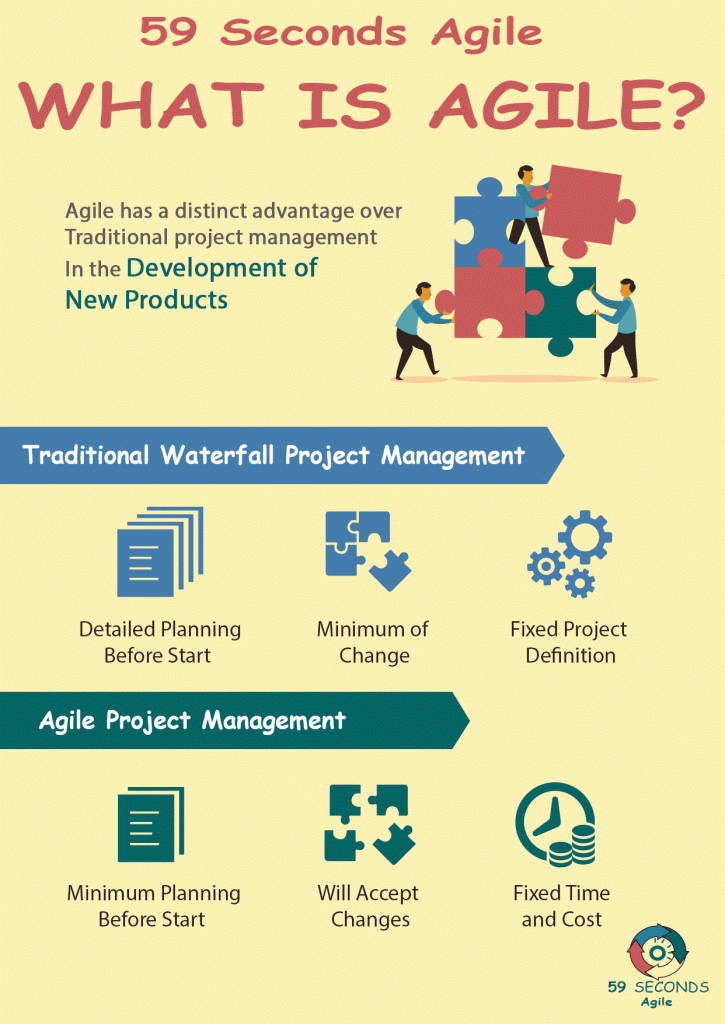Initiating an Agile Project
A 59 Seconds Agile Training Video
Continue to Part 5 Below
Initiating an Agile Project For Developers
A 59 Seconds Agile Article
This article provides a discussion on ‘Initiating an Agile Project’ and looks to discuss what Agile is and the processes involved when starting an Agile project.
Initiating an Agile Project
How do you know which documentation is actually necessary and valuable to your project? The point of the documentation is to make sure that the team knows what they’re about to do.
The beginning of a product’s development always takes place outside of the scrum project that it becomes a part of. That means that because the scrum team isn’t the source for the idea of the product, someone has to give them a concept.
An ideal concept strikes the balance between enough detail to know what the product is supposed to accomplish, without providing so much detail that the scrum team has no room to be flexible. One extremely useful tool that can be provided to the scrum team is a value proposition canvas for the product. This type of vision board helps the scrum team understand the product by means of how a customer would want to use it.
The canvas includes the ideal customer’s motivation for using this particular product and any pain points he may have. The canvas then includes a product description that lists how it would remove pain points plus add additional gain. This type of concept is useful for scrum teams, because it helps them begin the project with their customer already in mind. You may be thinking that it’s good information to know, but how can it help the team know where to start on the documentation they need?
The scrum team can use the value proposition canvas to create a product vision board, which visually represents the product. The board includes the vision statement, which is the idea of the product in one sentence, the target group, the needs that the product will fulfil, and the value, or how your company will measure the success of the product.
In agile, this vision takes the place of a traditional rigid contract, which can be extremely inflexible for the development team to work under. Instead, the project vision is barebones and can change depending on the needs of the product. A key aspect of the project vision is that the stakeholders need to be involved in creating it; that way, the chance of misunderstandings is greatly reduced.
The scrum team talks to the stakeholders about the functionality, design, behaviour, and other aspects of development to get a rough idea of what they’re envisioning for the product.
The product owner can also work with the stakeholders to get an idea of what they do and don’t like. This is a lot of information to try and collect into one document, but just remember: the project vision should clearly state the goals of the product.
Continue Reading —> Next
Initiating an Agile Project:
A 59 Seconds Agile Video Animation
Continue Reading —> Next
User Stories Applied
A 59 Seconds Agile Book Review
User Stories Applied by Mike Cohn is one of our favourite books on Agile User Stories. The book starts with an overview into user stories, and details what a user story is and the different aspects of them. He then discusses how to go about writing a user story, and provides details of the INVEST criteria that can be used to determine if the story is meeting all of its objectives. Next Mike gives an in depth discussion of who user stories are written for and where to begin when gathering the details for them. The book then discusses acceptance testing user stories, including how to go about specifying these criteria and the responsibilities of the development team and customers during this process.
Continue Reading —> Next
What is Agile?
A 59 Seconds Agile Infographic

Continue Reading —> Next
Agile Scrum Master Training Course
Our Favourite Agile Books
We found these books great for finding out more information on Agile Scrum:
Continue Reading —> Next


